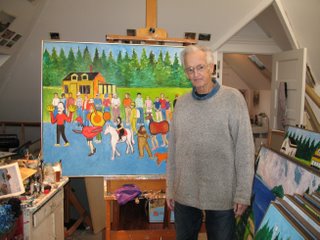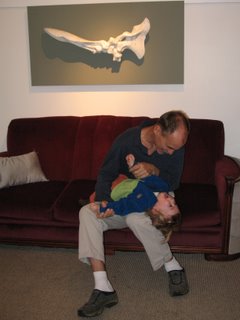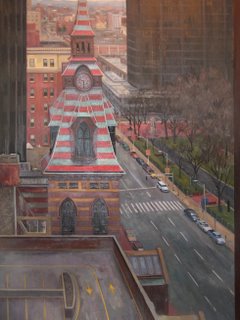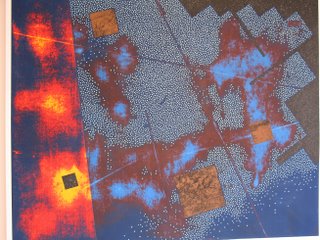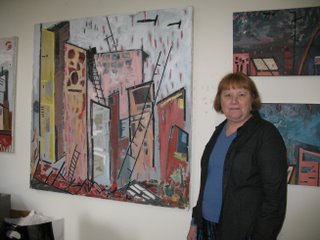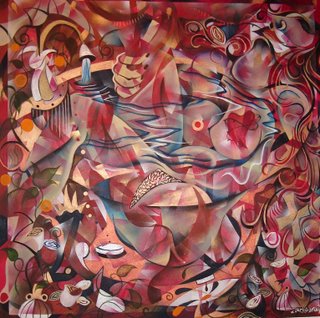City-Wide Open Studios50 Orange St., New Haven, (203) 772-2709
City-Wide Open Studios Main ExhibitionOpening reception Fri., Oct. 13, 5-8 p.m. Ends Oct. 29, 2006.
It's that time of year again. As the trees put on their annual color show, letting their leaves fall in multi-hued magnificence, so too does the greater New Haven visual arts community let down its hair, open its doors and offer art lovers a peek inside the creative process. Yes, City-Wide Open Studios, which debuted in New Haven as a one-weekend event in 1998, is back.
And, once again, it is spread over three weekends. This first weekend (Oct. 14-15) attention is paid to the artists laboring in the sprawling Erector Square complex on Peck Street. Weekend two (Oct. 21-22) promotes visits to artist studios in the neighborhoods of New Haven, West Haven and Hamden, either on your own or as part of bike or bus tours. It all culminates, like a July 4 grand finale, with 300 artists transforming the Alternative Space—this year sited in the four buildings of the old Hamden Middle School—with installations, music and makeshift galleries (Oct. 28-29).
According to
Artspace Executive Director
Helen Kauder—one of the three original organizers, along with
Marianne Bernstein and
Linn Meyers—some 475 artists are participating this year. That is down slightly from last year. With a smaller alternative space, says Kauder, organizers didn't as aggressively recruit some artists who were wavering in their interest. Kauder does note that a large group from
Paier College of Art in Hamden will be participating this year during the Neighborhoods weekend.
The Neighborhoods weekend has traditionally been the toughest sell. Artists are spread over more than three communities. Many are in their home studios. While some higher profile artists entertain a steady stream of visitors, others at times have felt left out. To address this problem, CWOS has organized tours by bike and bus over the past few years.
"It's problematic because people like the one-stop shopping-ness of the first and third weekends," Kauder says. Kauder herself took the bus tour last year and will be leading the Saturday tour this year. (Kate Paranteau, Program Director at
Creative Arts Workshop, will helm Sunday's bus tour.) A bike tour each day will be led by artist and cycling aficionado Matthew Feiner, owner of the
Devil's Gear bike shop.
"It was so much fun. Crossing the threshold into an artist's studio with a large group, you have the sense that
you are the party," Kauder enthuses of her bus tour experience. "The sense of discovery in the middle weekend is what's exciting."
That exciting sense of discovery permeates the Artspace Gallery, which hosts the main Exhibition. Each artist is allotted a 20"x20" space, either within the grids on the wall or, for works unsuited for hanging, on pedestals. The walls are festooned with hundreds of works over a range of media-painting, drawing, mixed media, collage, printmaking, carved wood, photography (film and digital) and even cut bronze on canvas. The pedestals display all manner of ceramics, soft sculpture, jewelry, woodcarving, sculpture and found object assemblages. Some of the work is magnificent, much of it is quite compelling and—let's face facts—some evidences more heart than talent.
All these works are teasers. They are enticements to take the trek to an artist's home studio or to Erector Square or to the Alternative Space extravaganza. It is impossible in a short space to do justice to all the notable works in the show. But I wanted to comment on several to give a flavor of what is offered.
Silas Finch's "Elephant Dance" is a delightful sculptural work cobbled together from found metal and leather objects. An oil can spout forms the elephant's trunk. The f
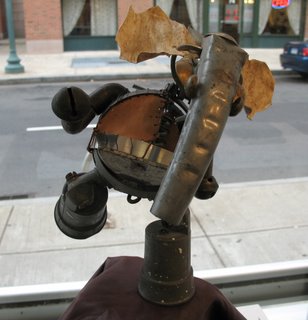
igure is posed in such a way-prancing on one leg-that it communicates pure kinetic joy. A sense of play is also at work in
E. Fitz Smith's "Flirtility Series," two digital prints with ink. They look like a cross between airbrush paintings, silkscreen prints and Adobe illustrator designs. There are echoes in the imagery of
Tom Wesselmann's Pop Art paintings, and a touch of the Cartoon Channel, too.
Erich Davis' untitled sculptural work is constructed out of dark gray nails. They swirl up out of a black disk base, a waterspout in full ascension. All the nails point upwards, bristling like missiles in an editorial cartoon.
Kelly Kapp's "Birdsong" also uses everyday items in sculpture. Kapp assembled a giant bird's nest from colorful leftover toys, discarded pieces of electronics and other detritus of disposable consumer society.
Peter Weaver's "Endless Enigma- 1974" is a carved wood sculpture. It is a Moebius strip that keeps turning in upon itself.
It is evident this year that digital photography is taking over.
Bradley Wollman's untitled inkjet print is just one example. Shot in an orchard, it shows decrepit wood
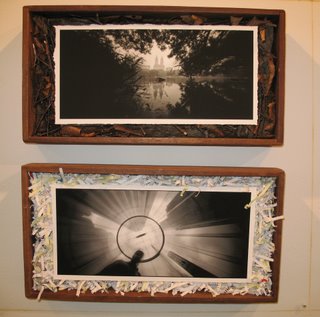
holding bins for apples scattered about. A tree on the left is bursting with red ripe fruit. But overhead, in an incongruous magical realist twist, a swarm of red paper airplanes zoom into the distance like monarch butterflies migrating to Mexico.
Still, there are diehards clinging with creative tenacity to traditional photographic methods. Particularly striking are
Michael Williams' "Big Apple Isan Remo Pinoramas," two pinhole camera photographs set within boxes. The boxes double as frames. The top one is filled with dried leaves and twigs. The photo set on top of them is an image of New York City shot through an opening of brush over a body of water. The twigs and leaves complement the imagery. Similarly, in the bottom photo, the camera looks up at a person looking downward within a converging canyon of skyscrapers. The print is embedded in a box of shredded office documents.
An urban street is also the setting for
James Polisky's silkscreen print, "Parade of Aviating Doom." In this four-color image, a giant Macy's Thanksgiving Day parade balloon hovers in the top two-thirds of the composition. But this is a balloon from hell: a little hip-hop style, a little bit Jack Skellington from
Tim Burton's
The Nightmare Before Christmas with mouth stitched closed and white crosses in its black lifeless eyes. A panda to scare the kiddies. The sky is a dark, almost midnight, blue. In the background a mustard-colored apartment building looms.
On the more conservative end of the art spectrum—but still in a city street—there is
Vladimir Shpitalnik's watercolor "Amsterdam." We look down a narrow street covered by water. The building facades on the right are lit with golden afternoon sunlight. The sky is a hazy gray tinted with yellow. Shpitalnik is totally in control of his medium, capturing the character of light in water and pigment.
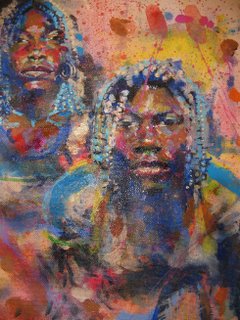
I was also struck by
Katro Storm's mixed media painting "The William." On first glance a modest and unassuming portrait of two African-Americans, it reveals its offhand beauty on closer inspection. Storm has captured the contours of the faces, the beaded hair and the lighting with a daring use of color.
Most of these artists were new to me. But viewing examples of their work in the main exhibition has catalyzed my desire to see more of what they have done. As well, I look forward to checking out new work by the many participating artists I have long admired. Whether you are interested in representational or abstract art—or all the work that falls on the spectrum in between—CWOS has something, and then some, for you.
 said. He said a friend, who once taught at the school, told him that a principal and assistant principal had both died of cancer.
said. He said a friend, who once taught at the school, told him that a principal and assistant principal had both died of cancer.


